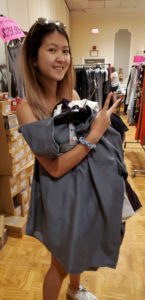Most popular clothing stores these days are considered fast fashion.
The cheaply priced and cheaply made clothing is produced at breakneck speeds to reflect the ever changing trends and consumer demands. Stores like H&M, Forever21 and Urban Outfitters are the mainstays of fast fashion. Thrifting, alternatively, is an even cheaper, environmentally friendly, and unique way to shop for clothing. It’s a great feat to be able to practice sustainability and environmentally friendly practices while still looking great.

Here are some important things to know when deciding whether to invest in the fast fashion industry or go the route of second-hand shopping.
1. Let’s start with the easiest benefit to thrifting— it’s cheaper. Thrifting is cheaper for the bank account of the person buying the clothing, and can be incorporated into business’ budgeting as well. If big clothing companies started buying thrifted items and reworking them into an even more unique piece, great clothes would be produced and less money would be spent on producing hundreds of fast fashion items.
2. Reusing clothes greatly reduces waste. To create synthetic fibres such as polyester, a lot of energy is needed. Harmful substances such as crude oil also play into the manufacturing of polyester, and releases byproducts like toxic gases and chemicals into our atmosphere. Reusing clothes plays into the loop of buying less clothes which consequently leads to less clothes being produced.
3. Second-hand clothes are much less likely to end up in landfills compared to their fast fashion counterparts. If a thrifted item has made its way from an individual to the thrift store, it can be assumed that this is a sturdy piece of clothing and can withstand wear and tear. That puts less strain on the environment, as well-made clothing will last longer on people than in the landfills. Comparatively, fast fashion items are clothing made at a high speed and low quality; they end up in landfills much faster than clothes that have been thrifted even just once.
4. Reusing clothes also decreases the amount of pollution contributing to global warming. Soil and water are often polluted when the dyes used for clothes are washed down drains or improperly thrown away, due to inefficient regulations in many countries where cheap clothes are made. Having chemicals thrown into water and soil wreaks havoc in many ways, from farming practices to simply having clean drinking water.
5. Lastly, supporting thrifting versus fast fashion is better for the people making them. Large companies producing new clothes weekly often pay workers in underdeveloped countries just a few cents per hour to produce these clothes. Conditions are often not up to the perceived standard and when people buy from stores where these clothes come from, they are supporting the mistreatment of these individuals. By choosing second-hand clothing stores instead, the money will go to a company that promotes sustainability and environmentally friendly practices.
So, next time you’re shopping at the mall and complaining about the high prices of items, maybe head to the local thrift store instead. There are so many options around now as thrifting has gained popularity over the last couple years. Each item you buy second-hand (or donate) contributes to one less piece of clothing in the landfills. It is possible to have the best of both worlds: find unique clothing items and help save the environment!





























